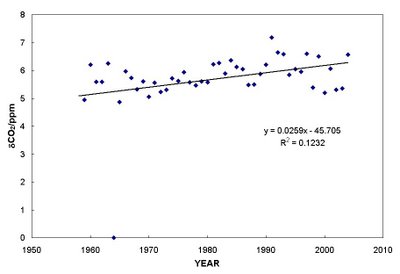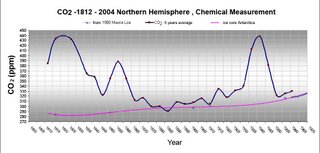Svensmark and co. attempt to rescue their cosmic ray forcing model in a paper published in Proceedings of the Royal Society, and a press release from the league of Danish global warming deniers, aka the Danish Space Center. The paper itself is not very strong, and comes to the unremarkable conclusion that in a smog chamber if you increase ion concentrations you will form more aerosols. The press release goes very far beyond the paper to claim that:
A team at the Danish National Space Center has discovered how cosmic rays from exploding stars can help to make clouds in the atmosphere. The results support the theory that cosmic rays influence Earth’s climate.
An essential role for remote stars in everyday weather on Earth has been revealed by an experiment at the Danish National Space Center in Copenhagen. It is already well-established that when cosmic rays, which are high-speed atomic particles originating in exploded stars far away in the Milky Way, penetrate Earth’s atmosphere they produce substantial amounts of ions and release free electrons. Now, results from the Danish experiment show that the released electrons significantly promote the formation of building blocks for cloud condensation nuclei on which water vapour condenses to make clouds. Hence, a causal mechanism by which cosmic rays can facilitate the production of clouds in Earth’s atmosphere has been experimentally identified for the first time.
Curiously, Eli picked up Richard Wayne's Chemistry of Atmospheres, and consulted the index. He identified for the first time
"Heterogeneous nucleation on pre-existing particles, although one of the most important mechanisms, is not the only way in which clouds and aerosols can be formed. Ion nucleation may be an important source of aerosol, especially in the stratosphere. Because of charge-induced dipol coulombic forces, ions have a greater tendency to attract molecules around them than do neutral species, between which the intermolecular forces are much weaker. Large 'cluster' ions are well known in the laboratory and will be discussed in Chapter 6. In the stratosphere balloon-borne mass spectrometers find the most abundant ions to be of the type HSO4-(H2SO4)n(H2O)m with n and m up to 4 or 5. (p84)
"Ionization in the stratosphere and troposphere arises mainly by interaction with glactic cosmic rays, with some contribution from radioactive decay in the last kilometer above the Earth's surfac. The primary processes give largely O2+ and electrons that attach to O2 to yield O2- (p510)
But actually folks, that was not what the paper was about. That was the press release. I guess it is time to call out the very proper science police. We will send Ethon to notify Officer Pielke who is currently on denial detail.
UPDATE: It occured to the old hare that he needs to use a hammer.
- Everyone accepts that cosmic rays are the principal source of ions in the lower atmosphere. The ion density is around 1000/cm3.
- Everyone accepts that there will be nucleation around the ions because of electrostatic forces
The Svensmark et al. paper simply restated the obvious. But the real questions are:
- Is the availability of ions the limiting factor in forming cloud condensation nuclei or is the availability of other species limiting.
- Are there other ways of forming cloud condensation nuclei (CCN) besides around ions and if so (it is so) what is the relative importance of each type of CCN and what are the characteristics of the CCNs.
Svensmark, et al added nothing to our understanding of these issues, but the press release claimed that they did and they themselves distended the envelope: (/Update)
However, experimental investigations exploring the role of ions in particle production are scarce and often at conditions far removed from those relevant for the lower part of the atmosphere. Here, we show that the production of new aerosol particles is proportional to the negative ion density under experimental conditions similar to those found in the lower atmosphere over oceans.
Unfortunately their conditions are far removed from the lower atmosphere. Maybe as far as Venus, but even there
Sadly No. The apparatus is a fairly large smog chamber. Smog chambers have been extensively used to study atmospheric chemistry, especially, surprise, smog. They are very large, so that wall effects can be minimized. They have deep UV light sources to initiate photochemistry, most often mercury lamps emitting at 254 nm, arrangements for moving gas through the system and probes for whatever.
The foul mix flowing of Denmark included a relative humidity of 2-90%, no problem there, 5 ppm of SO2, and a whole lot of ozone. The Danes had the ability to monitor the concentration of O3, but it is not given in the paper. Oh, yes, a fair amount of 254 nm light. Anyone with half a clue, any experience of 1950 London, 1960 LA or Mexico City anytime can predict what happened. The balance of the air, was air.
UPDATE: At
Real Climate Martin Enghoff, an author of the paper under discussion, states that the SO
2 5ppm mixture was diluted in the experiment down to 80-230 ppt, and that the ozone concentration was also diluted to 20-40 ppb. This was not stated in the paper, but fair is fair. A question that remains is how much UV light entered the chamber to create OH concentrations. Normal OH concentrations are of the order of 10^6/cm3. (In the atmosphere there are ~2x10^19 molecules/cm^3). SO
2 oxidation requires OH radicals, so the rate will depend directly on the amount of OH.
Average
tropospheric and
stratospheric SO
2 concentrations are below ppb (100 ppt) levels. Oceans emit dimethylsulfide (DMS) and not much SO
2. The Danish gas chamber ~5000 times more SO
2 than places where clouds form and maybe 300 times more than polluted place on the planet outside of a fairly nasty volcano or anwhere near E after he has had his cabbage.
Ozone, them Danes have more ozone than in the ozone layer for sure and like huge amounts more than you find in the troposphere. UV light, well, thanks to the ozone layer there ain't no damn 254 nm in this town sheriff.
What happens in the chamber is pretty simple. The 254 nm light photodissociates the ozone:
(1) O
3 + hv --> O(1D) + O
2 (wavelength below 310 nm mostly)
(1a) --> O(3P) + O
2 (wavelength above 310 nm mostly see
Ravishankara, et al for details)
O(3P) is the ground state of oxygen atoms. It is not very reactive compared to the excited singlet oxygen O(1D). Thus, since Svensmark, et al, made sure that they had a lot of ozone and 254 nm light they had a very high yield of O(1D), much more than you would in the atmosphere. The O(1D) abstracts a hydrogen from the water vapor
(2) O(1D) + H
2O --> OH + OH
reaction with O(3P) is much slower. The OH combines with the SO
2 to form HOSO
2
(3) OH + SO
2 +M --> HOSO
2 + M
M is anything else, like O
2 or N
2 in the atmosphere. The HOSO
2 reacts with oxygen
(4) HOSO
2 + O
2 --> HO
2 + SO
3
and the HO2 reacts with ozone to form OH
(5) HO
2 + O
3 --> OH + O
2 + O
2
You can look up the rates of these reactions at the
NIST Kinetics web site (warning, this is kind of the Wikipedia of reaction rate constants, there is no evaluation attempted) or look at a
critical evaluation.
There is also heterogeneous chemistry going on on aerosols and the walls of the chamber.
The SO
3 eventually goes to H
2SO
4 in aerosols. The moral of this is that to form sulfate aerosols you need SO
2 and when there is not a lot of SO
2 you can't form sulfate aerosols. You can see this in a study of
aerosol formation in Mexico City

The obvious result is that when ozone goes above 5ppb lots of small aerosol particles form. So what is limiting in the real atmosphere is SO
2, and almost certainly OH/O(1D).
Let us recap. Svensmark, et al studied the formation of aerosols in a smog chamber rich in OH and SO
2. In fact the concentration of these species was three or more orders of magnitude higher than in the troposphere and stratosphere.
UPDATE: See update above. The SO
2 concentration was high, but not out of the range of normal.
They varies the number of ions in the chamber and observed that more particles formed when the charge was increase.
Oh yes, I have some arguments with their proposed ion chemistry, but we will save that for another day.













